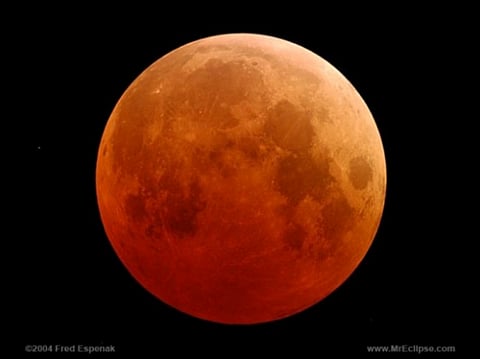

By Sandhya Ramesh
Early Monday morning, a giant moon will turn dark red as a supermoon coincides with a total lunar eclipse.
The last time this alignment of the Earth, Sun, and the Moon happened was on December 30, 1982, exactly a month after Michael Jackson had just released what would become the best selling album of all time, "Thriller". The next time this happens, on October 8, 2033, we would hopefully be hearing about it along with updates of what the humans that Elon Musk put on Mars are doing.
There are three things happening on Monday's event: an eclipse, a supermoon, and a bloodmoon.
A lunar eclipse happens when the Sun, Earth, and Moon are aligned in a straight line, in that order. The Earth blocks out the sunlight from the Moon and we see the Earth's shadow on it.
Image source: Smithsonian National Air and Space Museum
A total lunar eclipse occurs when the Moon is fully in the Earth's shadow, in the 'umbra' region. That's what Monday's event is. Well, for North America and Europe, anyway. If you're in India, expect to see a penumbral lunar eclipse. The Moon would be visible in the 'penumbra' region, where it is still relatively lit up by earthshine.
A supermoon occurs when the Moon is closest to the Earth in its orbit. The Moon has an elliptical orbit and every time it makes its closest approach to Earth (perigee) a perigee-syzygy or a Supermoon occurs.
Image source: blog.namestarlive.com
This phenomenon is relatively frequent. Every fourteenth full moon is a Supermoon. The Moon is expected to look 14% bigger and 30% brighter.
A blood moon occurs when in a total lunar eclipse, the Sun's rays are blocked and scattered by the Earth's atmosphere before falling on the Moon as earthshine. A full red blood moon is visible only in total eclipse.
Total eclipse of October 27, 2004 via Fred Espenak of NASA
In penumbral eclipse, expect to see a slight darkening tending towards browish red, but not fully red.
Visibility of the supermoon eclipse across the world:
Cities on the western parts of India have the best views, Image via Fred Espenak of NASA
Ideal times for viewing this supermoon penumbral lunar eclipse in India on the morning of the 28th are:
Chennai - 05:41 to 05:53
Bengaluru - 05:41 to 06:05
Mumbai - 05:41 to 06:25
Kolkata - Not visible.
New Delhi - 05:41 to 06:07
If you plan on taking out your camera, using a tripod is advisable. Do check the weather forecaset and make sure you get to your terrace a few minutes early to start seeing the Earth's shadow creep up on the lunar surface!